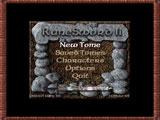 When Shrapnel Games presents
Rune Sword II, they’re not expecting anyone to swoon in the same way that, say, Black
Isle expects people to swoon over the next Baldur’s Gate installment. Where the
Baldur’s Gate series tackles role playing games with a graphics-intensive engine that
provides as much glimmer as substance, Rune Sword II’s characters are, graphically,
nothing more than two-dimensional bitmaps that blip around the combat screen. Where
Baldur’s Gate has animated characters hacking at one another, Rune Sword has
computerized dice clattering at the bottom of the screen. Where a killing blow will often
explode combatants into bloody chunks in BG, Rune Sword’s dead let out a wave-file
moan and then transform into a pile of bones.
When Shrapnel Games presents
Rune Sword II, they’re not expecting anyone to swoon in the same way that, say, Black
Isle expects people to swoon over the next Baldur’s Gate installment. Where the
Baldur’s Gate series tackles role playing games with a graphics-intensive engine that
provides as much glimmer as substance, Rune Sword II’s characters are, graphically,
nothing more than two-dimensional bitmaps that blip around the combat screen. Where
Baldur’s Gate has animated characters hacking at one another, Rune Sword has
computerized dice clattering at the bottom of the screen. Where a killing blow will often
explode combatants into bloody chunks in BG, Rune Sword’s dead let out a wave-file
moan and then transform into a pile of bones.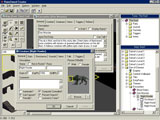 However, to attribute these
differences to game quality would be missing the point. Baldur’s Gate has flashy
graphics because it aspires to be, first and foremost, a computerized role-playing
game—to combine the charm of playing an RPG with the spark and sizzle that computer
gamers have come to expect. Rune Sword II, on the other hand, aspires to be a whole
role-playing system, like AD&D or Shadowrun.
However, to attribute these
differences to game quality would be missing the point. Baldur’s Gate has flashy
graphics because it aspires to be, first and foremost, a computerized role-playing
game—to combine the charm of playing an RPG with the spark and sizzle that computer
gamers have come to expect. Rune Sword II, on the other hand, aspires to be a whole
role-playing system, like AD&D or Shadowrun.
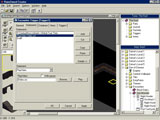 If
you’ve ever played one of these systems, you probably know that there are two kinds
of people involved with role-playing games. There are players who sometimes step into the
spotlight to claim a share of the glory but mostly enjoy watching things unfold around
them. And then there are game masters, who create and produce the spectacle, carefully
controlling how much glory there is to be had in the first place. Baldur’s Gate
stands in a tradition of games made exclusively for players, while Rune Sword II is made
for players and game masters alike. You could not use BG to create an adventure, for
instance, but Rune Sword contains Creator 2, an editing program designed precisely for
that purpose. In the considerably sized user’s manual, most of which is devoted to
explaining the nuances of Creator 2, Shrapnel Games states that, "If you want to make
role-playing games, or help others to do so, you’ve come to the right place."
If
you’ve ever played one of these systems, you probably know that there are two kinds
of people involved with role-playing games. There are players who sometimes step into the
spotlight to claim a share of the glory but mostly enjoy watching things unfold around
them. And then there are game masters, who create and produce the spectacle, carefully
controlling how much glory there is to be had in the first place. Baldur’s Gate
stands in a tradition of games made exclusively for players, while Rune Sword II is made
for players and game masters alike. You could not use BG to create an adventure, for
instance, but Rune Sword contains Creator 2, an editing program designed precisely for
that purpose. In the considerably sized user’s manual, most of which is devoted to
explaining the nuances of Creator 2, Shrapnel Games states that, "If you want to make
role-playing games, or help others to do so, you’ve come to the right place."
Where Rune Sword lacks the graphics of other computer RPG’s, it succeeds with a
broader and deeper range of role-playing possibilities. The emphasis here is on
imagination and story-telling. Character creation, for example, is managed by first
picking your character’s home region from a list of twelve possibilities, each of
which has its own characteristics and politics. Your character’s home region will
determine such attributes as strength, agility, intelligence, and what skills he or she is
capable of learning. Rangers, hunters, and trackers come from the wooded Northlands, for
instance, while brilliant merchants hail from Andoria. There is a region where the emperor
dwells and power is centralized, and there’s the land of clannish barbarians who
vehemently oppose the emperor’s rule. Characters can learn skills from Arcane Lore to
Battle Axe, from Healing Hands to one of four classes of spell-casting. The openness of
the skill system means that, although it makes sense to have a character who focuses
purely on healing, for instance, it’s nonetheless possible to have a sword-wielding
warrior who also practices certain schools of magic.
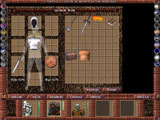 The
various regions and idiosyncratic character types make up the complex world of Eternia, a
place more comparable to the fully realized worlds of fantasy novels than the usual
settings of computer games. Where the Baldur’s Gate and Icewind Dale series depend on
the elaborate and extra-textual Forgotten Realms industry to evoke a fully realized
setting, Rune Sword presents a world with its own extensive history. The manual puts it
best: "With most computer RPG’s, there’s no distinction — you’re
going to save the world and kill the bad guy who has released his orc army to scour the
land. Then in the next game release, you have to save the world all over again. Because of
Rune Sword’s multiple adventure nature, however, our modules will connect with this
back story much more slowly. If your character(s) are to affect the course of history of
Eternia, they will have played through many adventures." In other words, players can
affect Eternia in much more open-ended ways than they can in comparable games.
Baldur’s Gate, for instance, progresses along a narrative arc that rarely deviates
from its prescripted path. Rune Sword has multiple adventures that each take their own
paths, and that might intertwine or might not. Furthermore, a single character or group of
characters can continue from adventure to adventure. This continuity of character is
reminiscent of ye olde table-top days, when you could play a single character through
several adventure modules for years at a time. Inhabiting the same alter-ego again and
again lead to a much richer role-playing experience than the single-campaign characters of
Icewind Dale or Planescape: Torment. Now, you can recover a taste of that experience.
The
various regions and idiosyncratic character types make up the complex world of Eternia, a
place more comparable to the fully realized worlds of fantasy novels than the usual
settings of computer games. Where the Baldur’s Gate and Icewind Dale series depend on
the elaborate and extra-textual Forgotten Realms industry to evoke a fully realized
setting, Rune Sword presents a world with its own extensive history. The manual puts it
best: "With most computer RPG’s, there’s no distinction — you’re
going to save the world and kill the bad guy who has released his orc army to scour the
land. Then in the next game release, you have to save the world all over again. Because of
Rune Sword’s multiple adventure nature, however, our modules will connect with this
back story much more slowly. If your character(s) are to affect the course of history of
Eternia, they will have played through many adventures." In other words, players can
affect Eternia in much more open-ended ways than they can in comparable games.
Baldur’s Gate, for instance, progresses along a narrative arc that rarely deviates
from its prescripted path. Rune Sword has multiple adventures that each take their own
paths, and that might intertwine or might not. Furthermore, a single character or group of
characters can continue from adventure to adventure. This continuity of character is
reminiscent of ye olde table-top days, when you could play a single character through
several adventure modules for years at a time. Inhabiting the same alter-ego again and
again lead to a much richer role-playing experience than the single-campaign characters of
Icewind Dale or Planescape: Torment. Now, you can recover a taste of that experience.
Although Rune Sword ships with premade adventures that can be played right out of the
box, playing the game is only a small part of the greater whole. If you’re looking to
treat Rune Sword as simply another RPG, you might think twice. That’s not to say you
won’t have fun playing Rune Sword. It’s just that you’ll be missing half of
the fun. With Creator 2, you can make new adventures from the ground up, so that
Eternia’s history is as fluid and changeable as imagination permits. You can create
adventure maps, place monsters or triggers that produce a random encounter, and even
script dialogue.
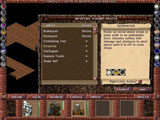 The
dialogue encounters are given special emphasis, for as the manual says, "You can take
the simplest, stupidest goblin monster there is, but if he says a couple of clever lines
before he dies, he’ll be memorable." Dialogue construction is at the heart of
story-telling in RPGs, and it gives you the opportunity to exercise a level of creativity
that is almost unique in computer gaming. While most computer RPGs are becoming
increasingly cold media, requiring a lot of problem-solving skills but less and less
imagination, Rune Sword allows you to experience role-playing from both sides of the dice
by challenging you to create fantastic scenarios of your own. These scenarios are then
posted on the game’s website
and shared with the rest of the world. In effect, this creates a community of gamers who
are all working with the Rune Sword system to impress one another with their ingenuity,
which translates to a virtually infinite number and variety of adventure modules. The
whole atmosphere smacks of cult following, though undoubtedly it will be a smaller
following than, say, the blank-eyed addicts of Everquest--smaller and probably smarter.
The
dialogue encounters are given special emphasis, for as the manual says, "You can take
the simplest, stupidest goblin monster there is, but if he says a couple of clever lines
before he dies, he’ll be memorable." Dialogue construction is at the heart of
story-telling in RPGs, and it gives you the opportunity to exercise a level of creativity
that is almost unique in computer gaming. While most computer RPGs are becoming
increasingly cold media, requiring a lot of problem-solving skills but less and less
imagination, Rune Sword allows you to experience role-playing from both sides of the dice
by challenging you to create fantastic scenarios of your own. These scenarios are then
posted on the game’s website
and shared with the rest of the world. In effect, this creates a community of gamers who
are all working with the Rune Sword system to impress one another with their ingenuity,
which translates to a virtually infinite number and variety of adventure modules. The
whole atmosphere smacks of cult following, though undoubtedly it will be a smaller
following than, say, the blank-eyed addicts of Everquest--smaller and probably smarter.
If rudimentary graphics and a no-frills playing interface sadden or anger you, then
Rune Sword II will surely disappoint. If you’re strictly a player of RPG’s, you
will probably be entertained, and you’ll definitely find a community of game masters
happy to feed you modules. But if you are a game master yourself, or if you’ve ever
been frustrated that the dialogue options in most RPGs don’t offer creative enough
options, and you’ve wondered who the hell writes this crap and why don’t they do
it correctly, then you’ll be thrilled that Rune Sword II presents the opportunity to
show the world how it’s done.
